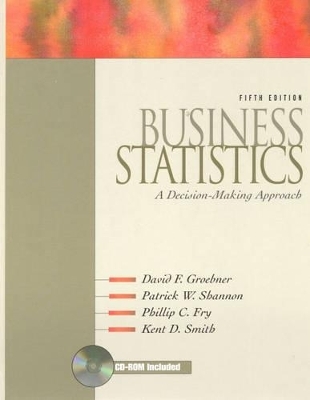
Business Statistics
Pearson
978-0-13-010856-2 (ISBN)
- Titel ist leider vergriffen;
keine Neuauflage - Artikel merken
(*Note: Each chapter concludes with Summary and Conclusions, Key Terms, Chapter Exercises and General References sections) 1. The Where, Why, and How of Data Collection. What Is Business Statistics? Tools and Techniques for Collecting Data. Populations, Samples and Sampling Techniques. Data Types and Data Measurement Levels. Using Your Computer. 2. Graphs, Charts, and Tables-Describing Your Data. Frequency Distributions and Histograms. Joint Frequency Distributions. Bar Charts and Pie Charts. Line Charts and Scatter Diagrams. Case 2-A: AJ's Fitness Center. Case 2-B: Westbrook Graphic Arts. 3. Describing Data Using Numerical Measures. Measures of Central Tendency. Measures of Variation. Using the Mean and Standard Deviation Together. Case 3-A: Wilson Corporation. Case 3-B: Holcome Financial Planners. Case 3-C: AJ's Fitness Center. 4. Using Probability and Discrete Probability Distributions. The Basics of Probability. The Rules of Probability. Discrete Probability Distributions. The Binomial Probability Distribution. The Poisson Probability Distribution. Case 4-A: Great Air Commuter Service. Case 4-B: Rutledg Collections. Case 4-C: Let's Make a Deal. Case 4-D: Belko Equipment Company. 5. Continuous Probability Distributions. The Normal Probability Distribution. Other Continuous Probability Distributions. Case 5-A: East Mercy 6. Introduction to Sampling Distributions. Sampling Error-What It Is and Why It Happens. The Basics of Sampling Distributions. Sampling Distribution of a Proportion. Case 6-A: Carpita Bottling Company. Case 6-B: Truck Safety Inspection. Case 6-C: Houston Nut and Candy Company. Case 6-C: High Country. 7. Estimating Population Values. Point and Confidence Interval Estimates. Determining the Appropriate Sample Size. Estimating a Population Proportion. Case 7-A: Duro Industries, Inc. Case 7-B: Management Solutions, Inc. 8. Introduction to Hypothesis Testing. Hypotheses Tests for Means. Type II Errors. Hypotheses Tests for Proportions. Hypotheses Tests for the Variances. Case 8-A: Campbell Brewery, Inc., Part 1. 9. Hypothesis Testing and Estimation For Two Population Parameters. Hypothesis Tests for Two Population Variances. Hypotheses Tests and Estimation for Two Population Means. Estimation and Hypothesis Tests for Two Population Proportions. Case 9-A: Green Valley Assembly Company. Case 9-B: U-Need-It Rental Agency. Case 9-C: Wilson Bearing Company. 10. Analysis of Variance. One-Way Analysis of Variance. Randomized Complete Block Analysis of Variance. Two Factor Analysis with Replication. Case 10-A: Consumer Information Association. Case 10-B: West Coast Bell System. 11. Introduction to Linear Regression and Correlation Analysis. Correlation. Simple Linear Regression Analysis. Uses for Regression Analysis. Case 11-A: Alamar Industries. Case 11-B: Continental Trucking. 12. Multiple Regression Analysis and Model Building. Introduction to Multiple Regression Analysis. Using Qualitative Independent Variables. Working With Nonlinear Relationships. Stepwise Regression. Determining the Aptness of the Model. Case 12-A: Dynamic Scales, Inc. 13. Introduction to Quality and Statistical Process Control. Quality Management and Tools for Process Improvement. Introduction to Statistical Process Control Charts. Case 13-A: Izbar Precision Casters, Inc. 14. Goodness-of-Fit Tests and Contingency Analysis. Introduction to Goodness-of-Fit Tests. Introduction to Contingency Analysis. Case 14-A: American Oil Company. Case 14-B: Bentford Electronics, Part 1. 15. Introduction to Nonparametric Statistics. Testing for Randomness Using the Runs Test. Nonparametric Tests for Two Population Centers. Kruskal-Wallis One-Way Analysis of Variance. Case 15-A: Bentford Electronics, Part 2. 16. Analyzing and Forecasting Time-Series Data. Introduction to Forecasting and Time-Series Analysis. Trend-Based Forecasting Techniques. Forecasting Using Smoothing Methods. Case 16-A: Park Falls Chamber of Commerce. Case 16-B: The St. Louis Companies. Case 16-C: Wagner Machine Works. 17. Introduction to Decision Analysis. Decision Making Environments. Decision Criteria. Cost of Uncertainty. Decision Tree Analysis. Risk Preference Attitudes and Functions. Case 17-A: Rockstone International. Case 17-B: Hadden Materials and Supplies, Inc., Part 1. Hadden Materials and Supplies, Inc., Part 2. Answers to Select Problems. Appendixes. Appendix A: Random Numbers Table. Appendix B: Binomial Distribution Table. Appendix C: Poisson Probability Distribution Table. Appendix D: Standard Normal Distribution Table. Appendix E: Exponential Distribution Table. Appendix F: Values of t for Selected Probabilities. Appendix G: Values of X for Selected Probabilities. Appendix H: F-Distribution Table. Appendix I: Critical Values of Hartley's Fmax Test. Appendix J: Distribution of the Studentized Range. Appendix K: Critical Values of r in the Runs Table. Appendix L: Mann-Whitney U Test Probabilities. Appendix M: Mann-Whitney U Test Critical Values. Appendix N: Critical Values of T in the Wilcoxon Matched-Pairs Signed-Ranks Test. Glossary. Index.
| Erscheint lt. Verlag | 14.11.2000 |
|---|---|
| Sprache | englisch |
| Gewicht | 1700 g |
| Themenwelt | Mathematik / Informatik ► Mathematik ► Finanz- / Wirtschaftsmathematik |
| Mathematik / Informatik ► Mathematik ► Statistik | |
| Wirtschaft ► Betriebswirtschaft / Management ► Unternehmensführung / Management | |
| ISBN-10 | 0-13-010856-1 / 0130108561 |
| ISBN-13 | 978-0-13-010856-2 / 9780130108562 |
| Zustand | Neuware |
| Haben Sie eine Frage zum Produkt? |
aus dem Bereich


